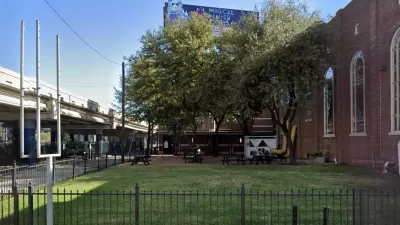This is a true story.
DISCLAIMER: This is a true story, but I do not pretend that it has great social significance. Just one of those many "lighter moments" in a planning career.
I was in my home state of Colorado, at a zoning board meeting. I do not recall why I was there (it must have worked out satisfactorily, or I would remember). I do remember one case that the board heard, however.
Colorado generally adheres to the "hardship" rule for variances. The board that evening had heard several cases and asked about the hardships in each. Late in the agenda, they called the case of a man who had been watching and listening attentively. He had a single-family home on a 7,500 square foot lot (numbers are vague in my memory, but numbers I use illustrate the point of the story) in a district that required a 6,000 square foot lot. That district allowed duplexes on 9,000 square feet. It did not allow mobile homes. He wanted to put a mobile home in his back yard, which, of course, required a lot-size variance, a variance on the type of structure, and some dimensional variances from setbacks. He was ready to tell his story.
"Well, it's about my mother in law. She's getting along in years. My wife has two sisters and a brother, but they all moved away and they never do anything useful for their mother. So my wife has to look after her. She's getting to the stage that she really cannot live on her own anymore. If you knew my mother-in-law, you would know that living in the same house with her would be a REAL hardship......"
The board granted the variance.

Alabama: Trump Terminates Settlements for Black Communities Harmed By Raw Sewage
Trump deemed the landmark civil rights agreement “illegal DEI and environmental justice policy.”

Planetizen Federal Action Tracker
A weekly monitor of how Trump’s orders and actions are impacting planners and planning in America.

The 120 Year Old Tiny Home Villages That Sheltered San Francisco’s Earthquake Refugees
More than a century ago, San Francisco mobilized to house thousands of residents displaced by the 1906 earthquake. Could their strategy offer a model for the present?

In Both Crashes and Crime, Public Transportation is Far Safer than Driving
Contrary to popular assumptions, public transportation has far lower crash and crime rates than automobile travel. For safer communities, improve and encourage transit travel.

Report: Zoning Reforms Should Complement Nashville’s Ambitious Transit Plan
Without reform, restrictive zoning codes will limit the impact of the city’s planned transit expansion and could exclude some of the residents who depend on transit the most.

Judge Orders Release of Frozen IRA, IIJA Funding
The decision is a victory for environmental groups who charged that freezing funds for critical infrastructure and disaster response programs caused “real and irreparable harm” to communities.
Urban Design for Planners 1: Software Tools
This six-course series explores essential urban design concepts using open source software and equips planners with the tools they need to participate fully in the urban design process.
Planning for Universal Design
Learn the tools for implementing Universal Design in planning regulations.
Clanton & Associates, Inc.
Jessamine County Fiscal Court
Institute for Housing and Urban Development Studies (IHS)
City of Grandview
Harvard GSD Executive Education
Toledo-Lucas County Plan Commissions
Salt Lake City
NYU Wagner Graduate School of Public Service





























